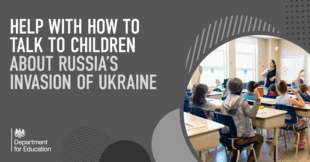
Russia’s invasion of Ukraine is distressing and concerning, and we understand children and young people may have questions or be seeking reassurance. We know that schools are well placed to talk to pupils about the images they are seeing and help them navigate the concepts and issues this brings up but we’re also aware that it raises issues some schools and teachers may never have encountered before.
Here we share some useful advice and resources for schools and teachers – but they may also be useful for families and young people themselves.
How to talk to young people about distressing complex, emotive news stories
The Educate Against Hate website is a useful resource when dealing with a range of issues relating to conflict, difficult classroom conversations and more. A post by Tom Bigglestone, a former Head of Humanities and now Online Learning Manager at The Economist Educational Foundation, encourages teachers to:
- Establish the facts by pointing pupils towards “trusted, reputable sources that explain the what, where, when, why and who”. It encourages teachers to challenge incorrect information when they see it and to present evidence for facts and get pupils to do the same
- Explore a range of diverse perspectives by considering the different voices within the classroom, showing solidarity with potentially marginalised voices and views and make sure it’s not left to a pupil to stand up for a particular minority viewpoint alone
- Be comfortable without an answer for everything – and help your pupils feel comfortable with that too – by being clear that in many circumstances there is no one ‘right’ answer
- Encourage students to debate ideas by facilitating discussion and helping pupils know that debate can happen without it becoming personal – by, for example, encouraging pupils to say they disagree with someone’s idea, rather than with the person.
Educate against hate also has a range of teaching resources aimed at promoting dialogue in the classroom that can support students to achieve a greater understanding of complex and sensitive topics.
How to spot mis- and disinformation and how to help pupils do the same
Mis- and disinformation are particularly prevalent during times of conflict and the risk posed by misleading narratives and information becomes more severe. Educate Against Hate hosts content produced by Be Internet Citizens, an educational programme developed by the Institute of Strategic Dialogue and YouTube. Covers topics including:
- How to identify mis- and disinformation (e.g. conspiracy theories, clickbait, manipulated media);
- Exploring fact versus opinion, including how sensational content can be used to drive user engagement;
- The benefits and pitfalls of a ‘personalised web’, including algorithms and filter bubbles;
- Understanding unconscious bias and how it influences our worldview;
- Analysing ‘us vs them’ narratives, and how online echo chambers may widen social divides;
- Responding effectively to hate speech and forging more inclusive digital communities;
- Creating inspiring digital content to champion causes, promote positive messages and support peers.
Educate Against Hate also hosts a one hour lesson plan from the Economist Educational Foundation that explores why conspiracy theories are more common in times of crisis, why people spread them and how they should be debunked.